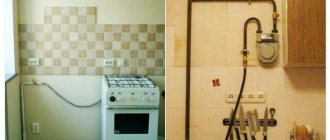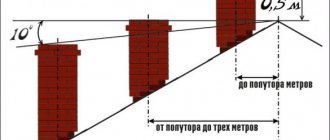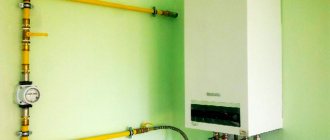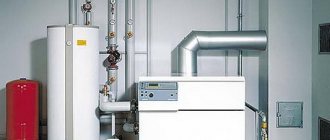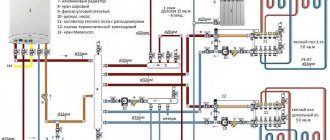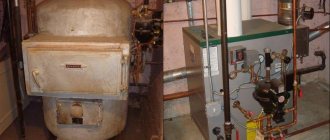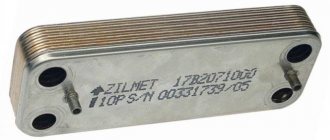Gas boilers are simple and easy to use, do not cause problems during maintenance, and effectively cope with their functional task. They are bought much more often than their electric and solid fuel counterparts, but not everyone knows that before turning on a gas boiler in an apartment or private house, preparatory measures need to be carried out.
In the article we present you will find useful information about starting a gas unit and the rules for preparing it for the upcoming work. We will talk about the features of filling the heating circuit with water. We'll show you how to enable and select the settings you need.
List of necessary actions
If it becomes known that the installation of individual heating is allowed in the house, a long visit to the authorities cannot be avoided:
- First of all, you need to go to the local organization responsible for gas supply and write a statement there regarding the installation of a gas boiler in the apartment. After a certain time, the home owner is given a conclusion regarding permission or prohibition to install the heating unit. Receiving a positive response means that the equipment can be installed.
- Next you will need a project. It should be ordered from a design office that has the right to carry out this type of work. Its address can be obtained from the gas supply company. At this stage, it is advisable to select a boiler model and meter. Design documentation must be drawn up for them, and the data must be indicated in the specification. The fact is that changes after approval can only be made later, and for a fee. If the project is signed, nothing can be changed in it; you need to order a new one.
- The fire inspection authorities should find out the address and name of the organization that checks the condition of ventilation ducts and agree with its specialists about the service. A company representative will come and check the quality of ventilation. If everything is in order, permission will be issued to install a gas boiler in the apartment. In case of unsatisfactory condition of the chimney, a report is drawn up with a list of work that should be performed. After eliminating the deficiencies, you need to re-invite a specialist in order to ultimately obtain permission.
- At the next stage, an application to refuse heating is submitted to the heating network. If you plan to heat the water yourself, you should also refuse hot water supply. It is advisable to immediately clarify the timing of the shutdown measures. You should already have a remodeling project approved by Gorgaz on hand.
- Data regarding the purchased meter and boiler are reported to the design organization. Then the completed documentation is collected. It is not worth purchasing equipment in advance, since permission to install a gas boiler in an apartment building cannot always be obtained.
- Then, at the Gorgaz branch, a contract for servicing the unit is concluded, and the gasification project is submitted for approval.
- After receiving the signed project, you can begin to disconnect from the heating network. In this case, you will need to drain the water from the heating system of the entire house.
- Next, the apartment owner must install an individual heating system. The boiler is installed without connecting to the gas main, the system is checked for leaks and readiness for operation.
- Gorgaz is finding out the date when a gas boiler can be installed in an apartment building in a specific apartment. Its employees will connect pipes and equipment according to the project, seal the meter, and put the stove and unit into operation.
- In order for the guarantee for a gas boiler to be valid, adjustment and first start-up will be required, followed by a mark in the passport. Regarding this type of work, you should contact the department where the device was delivered for service. The technician will adjust the boiler, start the system and put a stamp in the passport. Now you can use the installed equipment.
The entire process described above, in compliance with the requirements for installing a gas boiler in an apartment building, will take from 1.5 to 2.5 months. Therefore, it is advisable to start the procedure in spring or at the very beginning of summer.
How to use
In modern heater models, human participation is reduced to a minimum. Before the device is started, it is connected to:
- gas pipeline - gas service workers;
- heating pipes;
- water supply - representatives of organizations servicing heating systems.
The first start-up is also carried out by service workers. If the instructions are violated during connection and maintenance, the warranty will be void. The equipment must be used only for the purposes intended by the manufacturer.
During installation, maintenance and repair, original spare parts must be used. If a breakdown or incorrect operation is detected, the user must immediately turn off the gas valve and call the service or gas service. Carrying out repair work yourself is strictly prohibited.
When performing any work on or near an air duct or chimney, turning off the gas is mandatory. Having completed the work, they check the functionality of the chimney and air duct and only then proceed to start up the device.
Rules for installing gas appliances in an apartment
Owners of new apartments that are not connected to a centralized heating system have the least problems with arranging individual heating. In this case, there is no need to visit the heating network and there is no need to disconnect from the risers, and permission to install gas heating in an apartment building may be included in the package of real estate documents.
But even in this case, you need to adhere to certain rules. First of all, having the documents in hand, you cannot install gas equipment yourself - this work must be performed by specialists. These can be not only employees of the gas supply organization, but also representatives of a company that has a license for this type of activity.
After installation is completed, an engineer from the company supplying gaseous fuel will check that the connection is correct and issue permission to use the boiler. Only then can you open the valve leading to the apartment.
Before starting, in accordance with the requirements for installing a boiler in an apartment building, the individual heating system must be checked. To do this, it is launched under a pressure of at least 1.8 atmospheres. This parameter can be controlled using the pressure gauge of the heating unit.
If the pipes are built into the floor or walls, it is advisable to increase the pressure and drive the coolant through them for at least 24 hours. Only after testing the system can you be sure that there are no leaks and that the connections are reliable.
Before starting, the equipment must be vented. Since when installing a gas boiler in an apartment building the systems are made closed, you need to use Mayevsky taps available on the radiators. Each battery is emptied of air, going around them several times in turn until there is no air left in them. After this, the system can be put into operating mode - turn on the heat supply.
We should not forget that modern units are controlled using automation, and such devices are demanding on voltage. Therefore, it is recommended to use a voltage stabilizer and an uninterruptible power supply device. To protect the boiler from deposits that accumulate on its internal surface, filters must be installed at the points where fuel and cold water enter.
An electrical outlet and other gas appliance must be placed at a distance of at least 30 centimeters from the unit.
Precautionary measures
Despite the desire of manufacturers to ensure the safety of gas appliances, they can still become a source of danger. The Ministry of Emergency Situations regularly reminds owners of any gas-powered equipment about the following precautions:
- You need to buy gas-powered appliances from organizations that have the appropriate sales license.
- Installation should only be carried out by specialists from the relevant services.
- The kit should include an instruction manual.
- It is prohibited to change the design of the device in any way.
- A technical inspection must be carried out annually.
- It is prohibited to reduce ventilation openings in windows and walls.
- If there are sealed windows, it is necessary to organize air flow.
- Materials that can quickly ignite should not be stored in the boiler room.
- It is prohibited to increase the coolant temperature above 90°C.
Arrangement of the premises for the boiler
It is best to install a wall-mounted gas appliance in a kitchen whose layout complies with the standards for the placement of such equipment. Also, this room already has water and gas connections.
Here's what the standards for installing a gas boiler in an apartment look like:
- The area of the room where it is planned to install the equipment, when the ceilings are not lower than 2.5 meters, must exceed four square meters.
- It is mandatory to have a window that opens. Its area should be 0.3 square meters. m per 10 cubic meters of volume. For example, the dimensions of a room are 3x3 meters with a ceiling height of 2.5 meters. The volume will be 3x3 x2.5 = 22.5 m3. This means that the area near the window cannot be less than 22.5: 10 x 0.3 = 0.675 square meters. m. This parameter is for a standard window 1.2x0.8 = 0.96 sq. m. It will do, but the presence of a transom or window is required.
- The width of the front door cannot be less than 80 centimeters.
- There must be ventilation holes located under the ceiling.
Posting rules
- The area of the room in which the heater is installed is at least 7.5 m².
- Ceilings - from 2.2 m.
- There must be a window providing access to air from the street.
- The door should open in the direction of movement of the person leaving the room.
- It is prohibited to install switches in the boiler room. If they are already installed, you will have to take them outside the premises.
- It is necessary to equip supply and exhaust ventilation. For every m³ of fuel consumed - 15 m² of air.
- The distance from the heater to elements capable of burning is 25 cm or more. To non-combustible elements - 5 cm. From the chimney to combustible parts - 40 cm, to non-combustible parts - 15 cm.
- The device is mounted on a perfectly flat plane, without slopes.
Recommendations for installing gas equipment
In the documents attached to the product, each manufacturer describes the requirements for installing a gas boiler in an apartment. For the manufacturers' warranties to be valid, the unit must be installed in accordance with their recommendations.
The list of requirements is as follows:
- The wall-mounted boiler is separated from the walls using non-combustible material. When they are tiled or covered with a layer of plaster, this will be enough. You cannot immediately hang the device on a surface lined with wood.
- The floor-standing unit is placed on a non-combustible base. If the floor has ceramic tiles or is concrete, you don't need to do anything. You need to put a sheet of heat-insulating material on a wooden floor covering, and fix a metal sheet on top of it, the size of which exceeds the dimensions of the boiler by 30 centimeters.
Fire safety standards
In order for a gas heating system to comply with fire safety standards, certain conditions must be met:
- Atmospheric devices can be located in the attic, basement or any other floor of the house. It is prohibited to place these units in the basement.
- Turbocharged gas boilers are allowed to be installed in any non-residential premises, as well as in the attic and basement.
- Doors to rooms containing gas appliances must open outward.
- The boiler room is finished with fireproof materials with a minimum fire resistance limit - no less than EI45.
- Turbocharged mounted gas boilers are fenced off from the adjoining wall with a shield made of non-flammable material. Floor-standing models are placed on a fire-resistant lining.
Flammable interior elements may be installed next to the boiler no closer than 30 cm.
Requirements for chimney installation
When installing a gas boiler of any type in an apartment in an apartment building, the chimney cannot be made narrower than its outlet pipe. If the device has an open combustion chamber and a power of no more than 30 kW, the cross-section of the chimney pipe cannot be less than 140 millimeters, and with a productivity of 40 kW - 160 millimeters in diameter.
If the boiler has a closed combustion chamber, it is equipped with a coaxial chimney with a cross-sectional size recommended by the manufacturer.
Next you need to adhere to the following rules:
- the pipe going upward from the wall-mounted gas unit must have a length of at least 50 centimeters, and only then can the elbow be installed;
- more than three bends cannot be created along the entire length of the chimneys;
- combustion products from appliances with open combustion chambers are removed into the chimney, and with closed ones, also into the chimney or through the wall directly to the street (the method depends on the project).
Regulations, laws and regulations
Let's immediately look at what decrees regulate such connections at the legislative level. They will help you implement your plans without problems with local authorities, without danger to health and life, and, moreover, with minimal waste of time and money.
You will need for review:
- SP 60.13330.2016 - “Heating, ventilation and air conditioning.”
- SP 62.13330.2011/SNiP 42-01-2002 - this describes gas distribution systems in detail.
- SP 41-108-2004 - a document on apartment-to-apartment heat supply using gasification.
- SP 402.1325800.2018 - “Rules for the design of gas consumption systems.”
And of course, general research into the documentation of your apartment building is necessary.
Choosing a gas boiler
Before installing a boiler in an apartment, you need to make the best choice. In a multi-storey building, you can install wall-mounted and floor-mounted boilers. Wall-mounted models are considered more aesthetically pleasing and convenient for placement. Their dimensions are comparable to the dimensions of kitchen wall cabinets and therefore they fit well into the interior of the room.
Installing floor-mounted units will be more difficult, since they cannot always be moved close to the wall. This nuance depends on the location of the smoke exhaust pipe. If it is on top, then the device can be moved towards the wall if desired.
Boilers are also single- and double-circuit. The first of them work only for heat supply, and the second for heating and water heating. When other equipment is used for DHW, then a single-circuit model will be sufficient.
If the water is heated by a gas boiler, then you will have to choose one of two methods: an indirect heating boiler or a flow-through coil. Both options have disadvantages. When a coil is used, which means flow-through heating is carried out, not all units are able to maintain the set temperature.
For this reason, boilers need to be set to special operating modes; they are called differently in different devices. For example, in Navien models (read about Navien boiler malfunctions), Beretta is “hot water priority”, and in Ferrolli it is “comfort”.
The disadvantage of boiler heating is that gaseous fuel is consumed to maintain a stable temperature of the water in the tank. In addition, the reserve of heated water is limited. After it is consumed, you have to wait until the new portion heats up.
The choice of the methods described above is an individual matter, but you need to remember that with a flow-through option you will have to focus on the water heating capacity per minute, and with a boiler - on the volume of the tank.
Gas units differ in the type of burner used, which are:
- single-position;
- two-position;
- modulated.
The cheapest are single-position ones, but at the same time they are the most wasteful, since they always operate at full capacity. A little more economical are two-position ones, which are capable of operating at both 100% power and 50%. Modulating burners are considered the best because they have many operating modes, which saves fuel. Their performance is managed automatically.
The burner is located in a combustion chamber, which can be open or closed. Oxygen for open chambers comes from the room, and combustion products are removed through an atmospheric chimney.
Closed chambers are equipped with a coaxial chimney structure, and oxygen for combustion is supplied to them from the street. In this case, combustion products are discharged along the central contour of the chimney, and air enters through the outer one.
Floor-standing units are equipped with an inflatable or atmospheric burner. When a floor-standing model boiler is installed in an apartment building, it is allowed to use an atmospheric burner in the apartment. Most of these gas appliances have a closed combustion chamber, which means they are equipped with a turbine and a coaxial chimney.
Ignition instructions
Heaters differ in the type of ignition, so when starting different modifications there are some nuances. Before turning on the device, you need to read the ignition instructions to ensure everything is done correctly. Let's look at ignition using the example of the Italian boiler "Ariston". Before turning it on, it is important to check the system for leaks. For this purpose, the thermostat is turned on to maximum so that the switching occurs automatically. Ariston ignition process:
- the device is connected to the power supply, and the heating regulator is set to the desired temperature value;
- When the pump is turned on, a slight noise is heard;
- when all air pockets in the pipes are eliminated, the noise will disappear;
- When the electric ignition is triggered, the boiler turns on automatically.
Boiler power calculation
When the type of heating unit is selected, you should decide on its power. If desired, you can order a thermal engineering calculation that allows you to determine heat loss in the premises. Based on this figure, they begin to select the boiler power.
You don’t have to make calculations, but use the standards obtained experimentally, according to which 1 kW of boiler power is required for 10 “squares” of area. To this result should be added a reserve of productivity for various losses.
For example, to supply heat to an apartment with an area of 60 square meters, you need a 6 kW device. If you plan to heat the water, add 50% and get 9 kW of power, and in case of abnormally cold weather another 20-30%. The final result is 12 kW.
But this is a calculation for central Russia. If the settlement is located to the north, the productivity of the unit should be further increased. The specific value depends on the degree of insulation of the house. For a panel or brick high-rise building this will be 50% or more.
The boiler must have sufficient power to ensure comfort in the apartment, so you should not save on it. The difference in cost will not be big. If you purchase an automated boiler, there will be no excess gas consumption, since such models of units are the most economical.
The process of obtaining permission related to whether it is possible to install a gas boiler in an apartment is quite complex, costly and time-consuming. But all the effort is worth it, since it is much better to live at a comfortable indoor temperature. At the same time, you will have to pay less for individual heating than for centralized heating.
Frost protection
One of the important rules for operating heating systems is to ensure the minimum permissible coolant temperature. If water is poured into the system, freezing occurs at low temperatures, and pipes and radiators become unusable. In modern models, this problem is solved - the user is relieved of the need to monitor the coolant.
For example, the boilers of South Korean Navien [/anchor] provide reliable protection against freezing. Navien is cheaper than its European counterparts, but these boilers have all the necessary protection functions, which greatly simplifies their use.
When the coolant temperature drops below 10°C, the circulation pump starts automatically. If the coolant cools down to 6°C, the burner automatically turns on, warming the coolant to 21°C.
Self-diagnosis
The process of operating heaters is simplified if they have a self-diagnosis function. Almost all European manufacturers have equipped their products with it.
For example, German Bosch heaters, displaying error codes on the display, allow the user to quickly understand the cause of the problem and take measures to eliminate it. If code A7 appears on the screen, it is clear that the hot water temperature sensor is faulty.
If A8 is displayed, the connection to the BUS bus is broken. This function greatly simplifies the use of gas equipment, making it easier and more comfortable.
